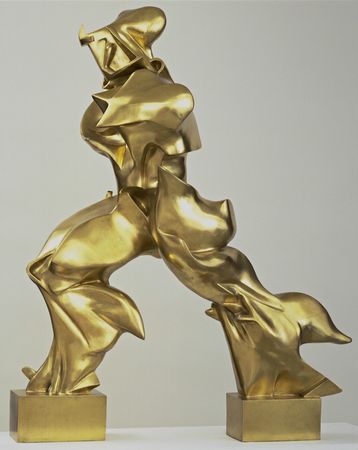Last weekend I spent a day at the Museum of Modern Art in New York City. Once again I encountered Umberto Boccioni's exquisite bronze sculpture Unique Forms of Continuity in Space. It stands on a pedestal in the center of the room and everyone entering is immediately drawn to its beauty.
Boccioni's piece represents the most perfect realization of Italian Futurism, and today marks the 100th anniversary of Marinetti's Futurist Manifesto, originally published in Le Figaro. The Manifesto is a masterpiece of bombast and hyperbole. Marinetti glorifies the velocity of modern life, represented by the automobile:
beauty: the beauty of speed. A racing automobile with its bonnet adorned with
great tubes like serpents with explosive breath … a roaring motor car which
seems to run on machine-gun fire, is more beautiful than the Victory of
Samothrace."
And already in this manifesto Marinetti intimates his later embrace of pure fascism with his aestheticizing of warfare:
patriotism, the destructive gesture of the anarchists, the beautiful ideas
which kill, and contempt for woman.
All of the modernist movements of the 20th century can be traced back to Marinetti and his Manifesto: Dadaism, Surrealism, Cubism all grew out of this ode to dynamism. But perhaps the purest successor movement was German Expressionism. Painters such as Kandinsky and Kirchner display the same infatuation with motion and color as Boccioni and Severini, and the poet Ernst Stadler could have been under the influence of the Futurist Manifesto when he wrote his 1913 poem Fahrt über die Kölner Rheinbrücke bei Nacht where the speed of the train and the explosion of lights bring the poet to a state of frenzied ecstasy.
Not as well known is Marinetti's political influence on the German avant-garde painters and writers, for Marinetti saw Fascism as the political expression of modernism. Some of this was already apparent in Ernst Jünger's 1920 book Storm of Steel (in Stahlgewittern), in which the horrors of World War I combat were transformed into a mystical, aesthetic experience. But the connection between Marinetti and German artists was much deeper, as the art historian Regine Reinhardt discusses in an interesting piece in Freitag. Reinhardt writes about Marinetti's embrace of National Socialism, and as late as 1934 it seemed like modernist art had a future in the Third Reich:
nationalsozialistischen Deutschland die futuristische Kunst als die
faschistische Staatskunst zu präsentieren. 1934 nahm Marinetti eine
Ausstellung futuristischer Kunst in Berlin zum Anlass für diese
Darstellung. Die Allianz von künstlerischer Avantgarde und Faschismus
schien zum damaligen Zeitpunkt auch in Deutschland noch möglich. (The relative marginalizing (of Futurism) did not prevent Marinetti from presenting futuristic art as the fascist state art of National Socialist Germany. In 1934 Marinetti attempted to make the case at an exhibition of Futurist Art in Berlin. At that time an alliance between the artistic avant-garde and fascism seemed like a possibility even in Germany.)
Of course, not long after this the Nazi functionaries rejected Modernist art totally, and those painters and writers – such as Emil Nolde and Gottfried Benn- who had embraced the Nazi movement now found themselves persecuted as "degenerate " (entartet).
Marinetti and his Futurists fared much better in fascist Italy. And even though he couldn't stand German painting in the Third Reich, he did appreciate the Nazi art of total warfare, and even followed the German army to Stalingrad. Unfortunately, Marinetti died before he could witness the most sublime realization of his Manifesto: the mushroom cloud.



0 comment
A long time ago I read a book about Italian fascism and its relationship to kitsch. Wish I could remember the name of it.